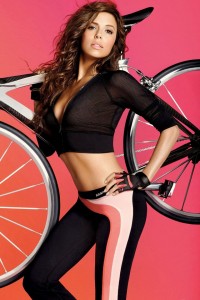Amy and I brought a couple of U.S. bicycles with us – and a bag full of skates and kid’s hockey equipment – when we returned to Brisbane.
We may be biking more, but won’t be entering any off-road races (that’s Amy on her previous bike, left, in Kansas, and below, right, today, both not exactly as shown).
Those who do, know there have been race-related outbreaks of Campylobacter and other bugs throughout the world, probably due to biking  through mud and crap on paths that may have been used by livestock or contaminated via runoff.
through mud and crap on paths that may have been used by livestock or contaminated via runoff.
Mud guards apparently work.
Norwegian researchers report in Epidemiol. Infect. (2013), 141, 517–523, that in 2009, following a bike race, a gastrointestinal illness outbreak affected many participants.
A cohort study showed an attack rate of 16.3% with the main risk factor being mud splashes to the face. Considering these findings, in 2010 recommendations to participants in the bike race were issued and environmental control measures were implemented. In 2010, a retrospective cohort study using web-based questionnaires was conducted to measure the use of preventive measures and to assess risk factors associated with gastrointestinal illness. A 69% response rate was achieved and 11721 records  analysed, with 572 (attack rate 4.9%) matching the case definition, i.e. participants reporting diarrhoea within 10 days of race. There was a clear increase in the use of mudguards (96.7% reported access to/receiving information on preventive measures) and a significant decrease in gastrointestinal illness. This may indicate that the measures have been effective and should be considered, both in terms of environmental control measures as well as individual measures.
analysed, with 572 (attack rate 4.9%) matching the case definition, i.e. participants reporting diarrhoea within 10 days of race. There was a clear increase in the use of mudguards (96.7% reported access to/receiving information on preventive measures) and a significant decrease in gastrointestinal illness. This may indicate that the measures have been effective and should be considered, both in terms of environmental control measures as well as individual measures.

.jpg) We followed procedure, ran ‘dog-found’ ads in the local paper, but no one claimed her. So we took her in.
We followed procedure, ran ‘dog-found’ ads in the local paper, but no one claimed her. So we took her in..jpg) Jonathan Maus, who publishes a blog called bikeportland.org said, "They expect a business to treat them the same whether they come in a car or on a bike."
Jonathan Maus, who publishes a blog called bikeportland.org said, "They expect a business to treat them the same whether they come in a car or on a bike."